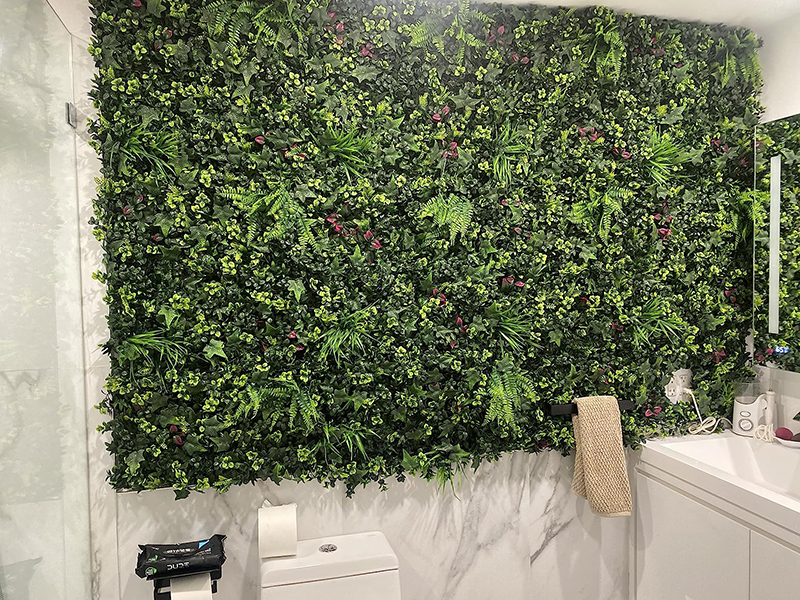The construction process of a 3D artificial vertical garden needs to take into account structural stability, plant growth requirements, and visual layering. The following is a detailed step-by-step description:
Site assessment
Analyze the load-bearing capacity of the wall or supporting structure to ensure that the load per square meter is not less than 80kg (steel structure keel + lightweight planting soil can optimize the load-bearing capacity).
Measure the size of the wall, the duration of light exposure and the Angle to determine the light requirements of the plants (for example, sun-loving plants should face south or have no obstructions).
Evaluate the drainage conditions, design the slope or reserve drainage holes to prevent water accumulation from causing plant root rot.
Functional zoning and visual design
Divide the functional areas according to the usage requirements (such as the ornamental area, the herb planting area, and the climbing plant area).
Design a 3D stereoscopic structure and utilize modular planting boxes, three-dimensional flower racks or bionic climbing systems to achieve a staggered spatial layout.
Plan the color and height matching of plants, for example, plant hanging plants (ivy, spider plants) in the lower layer, ornamental plants (roses, blue snowflakes) in the middle layer, and climbing plants (bougainvillea, wisteria) in the upper layer.
Installation of supporting structure
Install steel structure keels or anti-corrosion wood frames on the wall to ensure firmness.
Independent support columns need to be pre-embedded in the foundation and reinforced with concrete to prevent tilting.
Modular planting boxes need to reserve splicing interfaces to facilitate later expansion.
Selection of planting media and containers
Use lightweight and well-ventilated planting soil (such as a mixture of peat and perlite) to reduce the burden on the structure.
The planting containers should be root-controlling POTS or waterproof cloth bags to prevent excessive root growth and structural damage.
Climbing plants need to be equipped with grids, ropes or metal supports to guide their growth direction.
Plant selection and combination
Give priority to choosing plants with strong local adaptability, drought resistance and poor soil tolerance (such as Hosta, Vitriol and Sedum lineare).
Match plants with different flowering periods to ensure there are beautiful scenes throughout the four seasons (such as cherry blossoms in spring, jasmine in summer, chrysanthemums in autumn, and winter jasmine in winter).
Avoid planting plants with overly developed root systems (such as bamboo and banyan trees) to prevent structural damage.
Planting operation
Vertical gardens need to be planted in layers. Hanging plants should be planted at the bottom layer, foliage plants in the middle layer, and climbing plants in the upper layer.
When planting, pay attention to the distance between plants to avoid overcrowding that may affect ventilation and light.
Climbing plants need to be manually bound and guided to ensure their growth along the support.
Installation of intelligent irrigation system
Install a drip irrigation or micro-sprinkler system, connect a timer, and achieve automated watering.
The irrigation pipes should be hidden inside the structure to avoid affecting the appearance.
The rainwater collection system can be linked with the irrigation system to save water resources.
Daily maintenance
Prune plants regularly, control their growth direction and avoid blocking other plants.
Check the irrigation system monthly to prevent blockage or leakage.
Supplement slow-release fertilizer every quarter to ensure balanced plant nutrition.
In winter, cold-proof measures (such as covering with thermal insulation film) should be taken for plants that are not cold-resistant.
Safety inspection
Regularly inspect the stability of the support structure, especially for high-rise or independent support columns.
Avoid stacking heavy objects near vertical gardens to prevent structural overloading.
Toxic plants (such as oleander and water lily) should be avoided from being planted in children's activity areas.
Ecological optimization
Introduce carnivorous plants or mosquito-eating fish to reduce the breeding of mosquitoes.
Pair it with vanilla plants (such as mint and rosemary) to repel pests and enhance practicality.
Install solar lamps to provide lighting and create an atmosphere at night.

Contact: Amy
Phone: 86-15311787313
E-mail: info@foszmac.com
Whatsapp:86-15311787313
Add: Fengtai District, Dacheng Road, No.24 Building, Room 203, Beijing, China